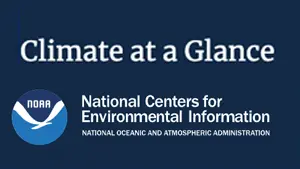 Climate at a Glance was developed at the request of NOAA Headquarters for near real-time analysis of monthly temperature and precipitation data across the contiguous U.S. and intended for the study of climate variability.
Climate at a Glance was developed at the request of NOAA Headquarters for near real-time analysis of monthly temperature and precipitation data across the contiguous U.S. and intended for the study of climate variability.
Since the fall of 2000, users have been able to request data for select cities, states, regions and the nation and compare current conditions with the historical record. More recently, various parameters (e.g. heating/cooling degree days and drought indicators), expanded regional options (e.g. counties, river basins, agricultural belts, etc.) and new analyses (e.g. Haywood plots and climatological rankings) have been added to enhance and broaden the capabilities of this tool.
The global component of Climate at a Glance provides global-scale temperature and precipitation information.
Temperature anomalies are provided by NOAA’s Global Surface Temperature Analysis (NOAAGlobalTemp), which uses comprehensive data collections of increased global coverage over land (Global Historical Climatology Network-Monthly) and ocean (Extended Reconstructed Sea Surface Temperature) surfaces.
Precipitation data are from the The Global Precipitation Climatology Project (GPCP) Monthly Precipitation Climate Data Record (CDR).
This tool provides near real-time analysis of monthly temperature and precipitation for the globe and is intended for the study of climate variability and change. Data is provided globally, by hemisphere, by regions, and by land and ocean surface components. The interactive mapping tool allows analysis of the spatial patterns of global and regional analysis. Recent data are preliminary and may be modified after appropriate quality control has been performed.
Click here to view the resource.




